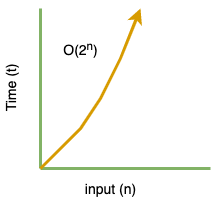In our last tutorial we learnt about Quadratic time complexity O(n2). If you have not read that article I would suggest you to read it first.
Quadratic time complexity O(n2)
What is Exponential Time Complexity O(cn)?
In exponential time algorithms, the growth rate doubles with each addition to the input (n). Let's look at the chart:

Let's take following example:
function pow(c, n) {
if (n === 0) return 1;
return c * pow(c, n-1);
}
console.log(pow(2, 2)); // 4
When we analyze time complexity of above function:
- each simple operation cost 1 unit of time i.e. comparison, multiplication, substraction etc..
- we can ignore other small operations like return statement
Looking at the function we are seeing that there are two conditions here:
- when n=0
- final condition when n=n-1
Here is the function call diagram:

Let say that for above function if we write the equation it would be:
Let say to calculate time complexity of pow(c, n-1) = T(n-1)
Other simple operations that happens in that function is c
T(n) = T(n-1) + c where n > 0 and c = some constant that we need to perform simple operations
T(0) = 1 when n=0 function returns 1
If you want to find:
T(2) = T(n-2) + 2c
T(3) = T(n-3) + 3c
T(k) = T(n-k) + kc
n-k = 0 for base case
then k = n
T(n) = T(n-n) + nc
= T(0) + nc
= 1 + nc because T(0) = 1
T(n) = O(n) considering bigger term from the equation and ignoring other constants
Therefore, total complexity of the statement: c * pow(c, n-1) = O(cn) which is a bigger term when analyzing out function complexity.